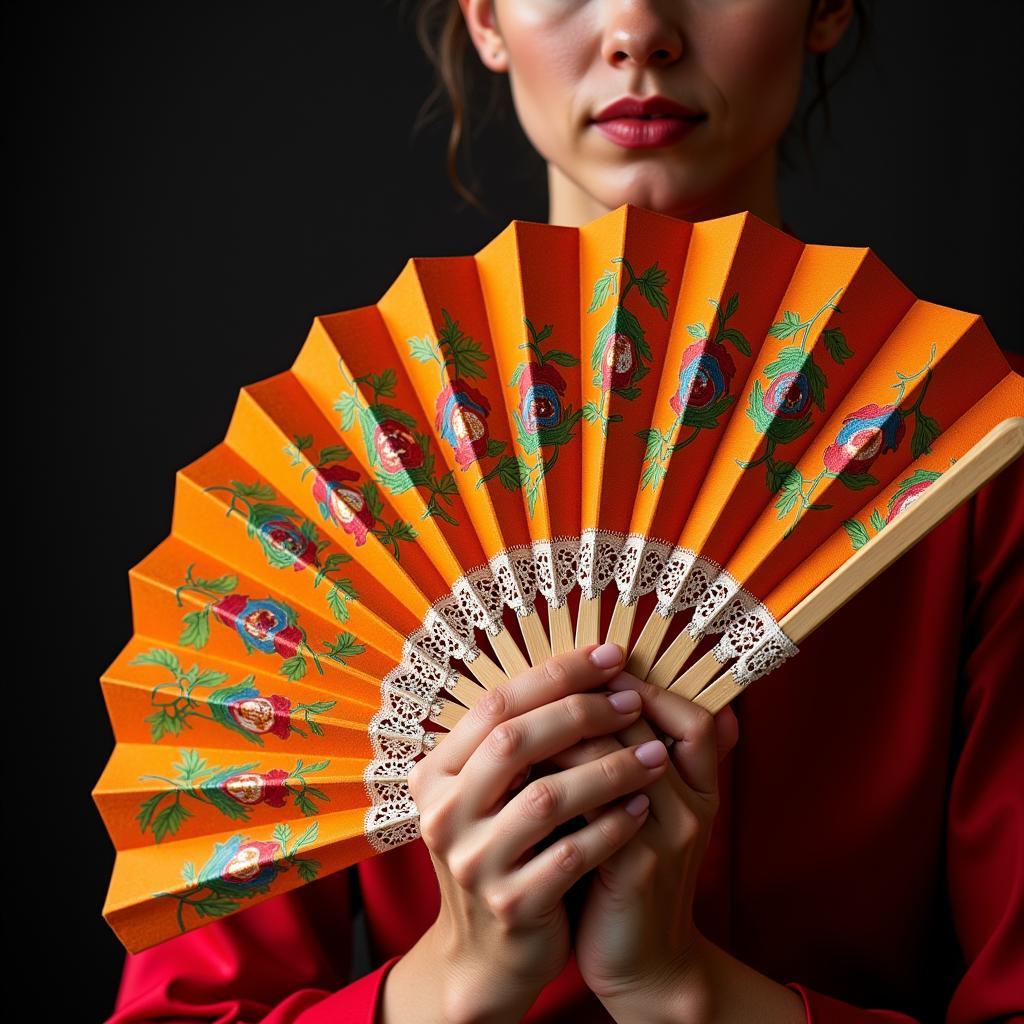Folding fans, known as “abanicos” in Spanish, are not mere accessories in the passionate world of flamenco. They are powerful tools of expression, adding a mesmerizing visual and symbolic layer to this captivating art form. While castanets and stomping feet often take center stage, the unassuming fan, with its graceful movements and intricate gestures, speaks volumes in the hands of a skilled flamenco dancer.
More Than Just a Pretty Accessory
 Flamenco dancer elegantly holding a fan
Flamenco dancer elegantly holding a fan
Imagine a flamenco dancer on stage, her dress swirling like fire as she moves. In her hand, she holds a fan, not just to cool herself but to tell a story. Each snap, flutter, and twirl of the fan conveys a different emotion, nuance, or plot point in the flamenco narrative. The way a dancer holds the fan, open or closed, high or low, can express joy, sorrow, anger, or coquetry.
The Language of the Fan
The use of fans in flamenco, much like the dance itself, is deeply rooted in Spanish culture. Dating back to the 18th century, fans served as essential tools for communication in a society bound by strict social etiquette. Women used fans to send secret messages, flirt discreetly, or express their emotions without uttering a word. This intricate language of the fan, with its specific gestures and meanings, became intertwined with flamenco, adding a layer of depth and intrigue to the dance.
Types of Flamenco Fans
Not all fans are created equal in the world of flamenco. Different styles and materials are favored for their visual impact and acoustic properties.
- Pericón Fans: Known for their large size and often adorned with colorful tassels, these fans create dramatic flourishes and enhance the dancer’s movements.
- Bata de Cola Fans: Smaller and lighter than Pericón fans, they are typically made of silk or lace and complement the elegant movements of the “bata de cola,” the long, train-like dress worn in some flamenco styles.
- Painted Fans: These fans become canvases for intricate artwork, often depicting traditional Spanish scenes or flamenco motifs, further enhancing the visual storytelling of the dance.
Mastering the Art of the Fan
Learning to use a fan in flamenco is no small feat. It requires precision, coordination, and a deep understanding of the fan’s expressive potential. Dancers spend years mastering the intricate wrist movements and finger techniques needed to bring the fan to life. The snapping sound of a well-timed fan opening or the gentle flutter of its folds adds another layer of rhythm and percussion to the flamenco performance.
Folding Fans: An Enduring Symbol of Flamenco
More than just a prop, the folding fan has become an enduring symbol of flamenco itself. Its presence evokes the passion, drama, and captivating storytelling that define this art form. Whether you’re a seasoned flamenco enthusiast or new to its captivating rhythms, understanding the role of the fan deepens your appreciation for this vibrant cultural tradition.
FAQ
-
What is the significance of the fan in flamenco? The fan is not just an accessory but a tool of expression, conveying emotions, nuances, and storylines within the dance.
-
What are the different types of flamenco fans? Common types include Pericón, Bata de Cola, and Painted fans, each with distinct characteristics and uses.
-
Is it difficult to learn to dance with a fan in flamenco? Yes, it requires dedicated practice to master the intricate hand movements and coordination needed to use the fan effectively.
Do you have a question about folding fans in flamenco?
Contact us! Our team of flamenco experts is here to help!
Phone: 0903426737
Email: fansbongda@gmail.com
Or visit us at: Tổ 9, Khu 6, Phường Giếng Đáy, Thành Phố Hạ Long, Giếng Đáy, Hạ Long, Quảng Ninh, Việt Nam.


